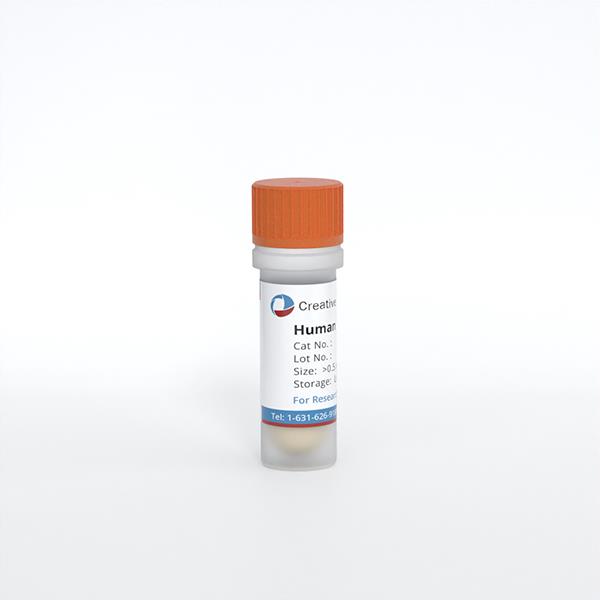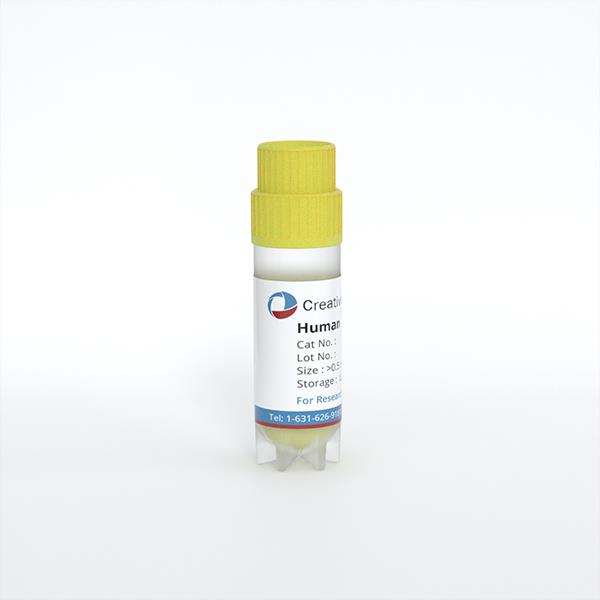Adipose Cells

Adipocyte biology has been intensely studied due to a global rise in obesity-associated health issues. In vitro models are invaluable in determining the mechanisms involved in adipocyte proliferation, differentiation, adipokine secretion, and gene/protein expression.
Adipose cells, also known as adipocytes or fat cells, are specialized to synthesize large globules of fat. There are two types of adipose cells: white adipose cells contain large fat droplets, only a small amount of cytoplasm, and flat, non-central nuclei; brown adipose cells contain fat droplets of different size, a large amount of cytoplasm, numerous mitochondria, and round, centrally located nuclei. The main chemical constituents of adipose cell are triglycerides, which are esters composed of glycerol and fatty acids, such as stearic, oleic, or palmitic acids.
Studies have shown that fat content in adipose cells has a significant effect on overall health. For example, too little fat cause reproductive dysfunction (e.g., female amenorrhea), whereas excess fat can lead to obesity, cardiovascular disease, cancer, or diabetes. There is also a group of rare hereditary disorders known as lipodystrophy, characterized by partial or complete loss of adipose tissue that may be acquired or inherited.
Human Subcutaneous Preadipocytes
Human subcutaneous preadipocytes are isolated from subcutaneous adipose tissue by centrifugal force after enzymatic digestion. The subcutaneous preadipocytes provide an ideal culture model to study the mechanism of adipogenesis as well as for screening drugs for metabolic diseases such as obesity, diabetes, and hypertension.
3T3-L1 Cell Line
The classic cell types for studying adipogenesis are established cell lines, such as the 3T3-L1 cell line, which are developed by clonal expansion of rodent-derived cells and only contain a single cell type. Although often thought to be immortal, the ability of 3T3-L1 cells to differentiate into adipocytes decreases with increasing number of passages. These cell lines are quite useful in identifying key molecular markers, transcription factors, and various interactions that are required for preadipocyte differentiation, and are therefore frequently used to rapidly screen and assess the adipogenic potential of various agents or cellular perturbations.
Mature Adipocytes
Mature adipocytes lose their lipid and return to proliferative competent cells in vitro. Mature adipocytes isolated from adipose tissue are less frequently used but may provide valuable information. Recent reports have documented methods to use floating adipocytes for the study of adipogenesis, and short-term maintenance of these cells has been achieved for the assessment of metabolic parameters, for example, the acute effects of insulin exposure on intracellular glucose transporter and hexose uptake have been evaluated in freshly isolated, mature adipocytes.
Filters Clear all filters
Species
- Bovine (22)
- Cat (45)
- Chicken (11)
- Chinchilla (1)
- Dog (118)
- Fish (1)
- Fruitfly (1)
- Goat (46)
- Guinea Pig (8)
- Hamster (94)
- Horse (1)
- Human (800)
- Minipig (2)
- Monkey (129)
- Mouse (875)
- Pig (110)
- Rabbit (249)
- Rat (324)
- Sheep (2)
- Squirrel (1)
- Turkey (1)
Source
- Adipose (32)
- Adrenal Gland (11)
- Airway (8)
- Anus (3)
- Aorta (86)
- Artery (180)
- Bile Duct (9)
- Bladder (49)
- Blood (193)
- Bone (13)
- Bone Marrow (157)
- Brain (163)
- Breast (64)
- Bronchus (43)
- Cartilage (29)
- Cervix (5)
- Chorion (5)
- Choroid (9)
- Ciliary Body (1)
- Colon (63)
- Conjunctiva (9)
- Cord Blood (24)
- Cornea (27)
- Dental Pulp (4)
- Dermis (111)
- Diaphragm (3)
- Ear (12)
- Embryo (24)
- Endometrium (11)
- Epidermis (26)
- Epididymis (3)
- Esophagus (35)
- Eye (95)
- Foreskin (2)
- Gallbladder (4)
- Gingiva (20)
- Hair Follicle (15)
- Heart (72)
- Intestine (152)
- Iris (1)
- Kidney (151)
- Lens (4)
- Liver (117)
- Lung (193)
- Lymph Node (27)
- Mesentery (18)
- Nose (5)
- Olfactory Bulb (1)
- Oral Cavity (12)
- Ovary (72)
- Oviduct (7)
- Pancreas (68)
- Pancreatic Duct (3)
- Pancreatic Islet (11)
- Parathyroid Gland (4)
- Penis (7)
- Perineurium (1)
- Periodontal Ligament (5)
- Periodontium (25)
- Peripheral Blood (153)
- Peritoneal Cavity (14)
- Placenta (29)
- Prostate (62)
- Pudenda (2)
- Rectum (3)
- Retina (38)
- Salivary Gland (3)
- Sclera (3)
- Seminal Vesicle (1)
- Skeletal Muscle (36)
- Skin (155)
- Small Intestine (56)
- Spinal Cord (10)
- Spleen (76)
- Stomach (37)
- Synovial Fluid (2)
- Synovium (13)
- Tendon (8)
- Testis (15)
- Thymus (51)
- Thyroid (34)
- Tongue (6)
- Tonsil (3)
- Tooth (4)
- Trabecular Meshwork (3)
- Trachea (46)
- Umbilical Cord (29)
- Ureter (10)
- Urethra (3)
- Uterus (61)
- Vas Deferens (1)
- Vein (104)
Cell Type
- Adipocyte (4)
- Astrocyte (34)
- B Cell (30)
- Basal Cell (3)
- Basophil (1)
- Beta Cell (3)
- Cardiomyocyte (18)
- CD133+ Cell (6)
- CD34+ Cell (21)
- Cholangiocyte (9)
- Chondrocyte (19)
- Dendritic Cell (15)
- Endothelial Cell (688)
- Endothelial Progenitor Cell (7)
- Eosinophil (1)
- Epithelial Cell (516)
- Fibroblast (473)
- Glial Cell (58)
- Goblet Cell (1)
- Granule Cell (2)
- Granulocyte (12)
- Granulosa Cell (1)
- Hepatic Stellate Cell (9)
- Hepatocyte (22)
- Interstitial Cell (10)
- Keratinocyte (24)
- Keratocyte (3)
- Kupffer Cell (8)
- Leydig Cell (3)
- Lymphocyte (84)
- Macrophage (31)
- Mast Cell (3)
- Melanocyte (11)
- Meningeal Cell (5)
- Mesangial Cell (10)
- Mesothelial Cell (5)
- Microglia (7)
- Microvascular Cell (308)
- Monocyte (16)
- Mononuclear Cell (110)
- Myeloid Cell (2)
- Myoblast (5)
- Myofibroblast (3)
- Myosatellite Cell (2)
- Neuron (50)
- Neutrophil (10)
- NK Cell (11)
- Oligodendrocyte (3)
- Oligodendrocyte Progenitor Cell (4)
- Osteoblast (8)
- Osteoclast (2)
- Osteocyte (3)
- Pancreatic Stellate Cell (4)
- Pericyte (20)
- Podocyte (5)
- Preadipocyte (21)
- Progenitor Cell (15)
- Red Blood Cell (12)
- Retinal Ganglion Cell (3)
- Satellite Cell (2)
- Schwann Cell (4)
- Sebocyte (1)
- Sertoli Cell (5)
- Skeletal Muscle Cell (11)
- Smooth Muscle Cell (241)
- Spermatogonium (3)
- Stromal Cell (41)
- Synoviocyte (11)
- T Cell (39)
- Tenocyte (8)
- Trabecular Meshwork Cell (3)
- Trophoblast (4)
Disease
- Acute Lymphocytic Leukemia (ALL) (15)
- Acute Myeloid Leukemia (AML) (13)
- Amyotrophic Lateral Sclerosis (ALS) (4)
- Aplastic Anemia (AA) (1)
- Arteriovenous Malformation (AVM) (1)
- Asthma (5)
- Astrocytoma (2)
- Autoimmune Hemolytic Anemia (AIHA) (1)
- Autoimmune Lymphoproliferative Syndrome (ALPS) (1)
- Breast Cancer (8)
- Cancer (144)
- Cervical Cancer (2)
- Chronic Lymphocytic Leukemia (CLL) (19)
- Chronic Myeloid Leukemia (CML) (14)
- Chronic Obstructive Pulmonary Disease (COPD) (6)
- Colon Cancer (9)
- Crohn's Disease (3)
- Cystic Fibrosis (CF) (7)
- Diabetes (110)
- Diabetes Type 1 (16)
- Diabetes Type 2 (18)
- Diffuse Large B-Cell Lymphoma (4)
- Dilated Cardiomyopathy (DCM) (1)
- Duchenne Muscular Dystrophy (DMD) (5)
- Essential Thrombocythemia (ET) (1)
- Glioblastoma (3)
- Guillain-Barre Syndrome (GBS) (1)
- Hypertension (27)
- Idiopathic Thrombocytopenic Purpura (ITP) (1)
- Inflammatory Bowel Disease (IBD) (5)
- Iron-Deficiency Anemia (1)
- Kidney Cancer (3)
- Legg–Calvé–Perthes Disease (LCPD) (2)
- Leukopenia (1)
- Liver Cancer (3)
- Lung Cancer (12)
- Mantle Cell Lymphoma (MCL) (8)
- Melanoma (2)
- Mucopolysaccharidosis (2)
- Multiple Myeloma (MM) (12)
- Multiple Sclerosis (MS) (3)
- Muscular Dystrophy (MD) (1)
- Myelodysplastic Syndrome (MDS) (3)
- Neurofibromatosis (NF) (3)
- Non-Hodgkin Lymphoma (NHL) (10)
- Normal (2466)
- Osteoarthritis (OA) (5)
- Ovarian Cancer (6)
- Pancreatic Cancer (3)
- Pancytopenia (1)
- Parkinson's Disease (PD) (2)
- Plasmacytoma (1)
- Polycythemia (1)
- Prostate Cancer (6)
- Psoriasis (4)
- Rheumatoid Arthritis (RA) (7)
- Robertsonian Translocation (ROB) (1)
- Sickle Cell Anemia (2)
- Systemic Lupus Erythematosus (SLE) (4)
- Thrombocytopenia (1)
- Transverse Myelitis (TM) (1)
- Ulcerative Colitis (UC) (2)
- Waldenström Macroglobulinemia (WM) (2)
Description: Preadipocytes are isolated from omental, mesenteric, or perirenal adipose tissue and are tested for ...
Description: Preadipocytes are isolated from omental, mesenteric, or perirenal adipose tissue and are tested for ...
Description: Visceral preadipocytes can be cultured as growing precursor cells or differentiated into adipocytes ...
Description: 3T3-L1 murine adipocytes have been fundamental in metabolic disease research for over 30 years. ...
Description: Adipocytes play an important role in energy storage and metabolism. Adipocyte differentiation is a ...
Description: Microvascular endothelial cells line blood vessels and contribute to many biological processes such ...
Description: Preadipocytes, found in adipose tissues throughout adulthood, can proliferate and differentiate ...
Description: Diseased Preadiopcytes are isolated from diabetic type I donors. Further donor information may be ...
Description: Diseased Preadiopcytes are isolated from diabetic type II donors. Further donor information may be ...
Description: Diseased Preadiopcytes are isolated from diabetic type I or type II donors. Further donor ...
Description: Diseased Preadiopcytes are isolated from diabetic type I or type II donors. Further donor ...





